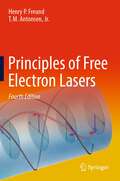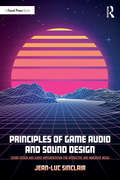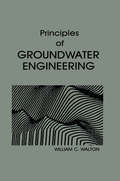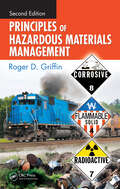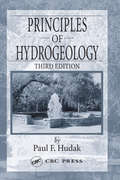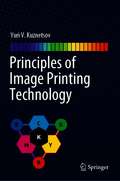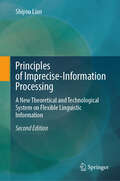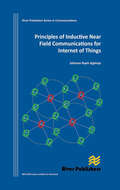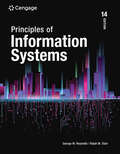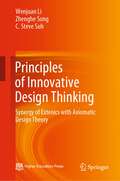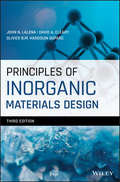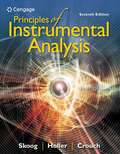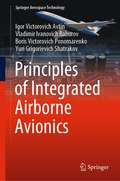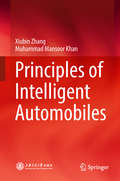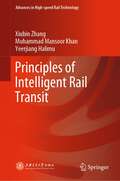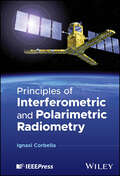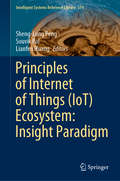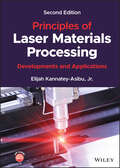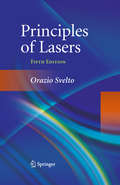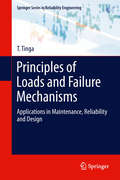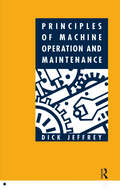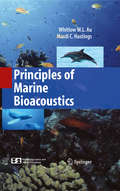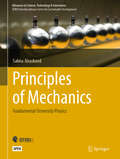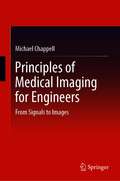- Table View
- List View
Principles of Free Electron Lasers
by Henry P. Freund T.M. Antonsen, Jr.This book presents a comprehensive description of the physics of free-electron lasers starting from the fundamentals and proceeding through detailed derivations of the equations describing electron trajectories, and spontaneous and stimulated emission. Linear and nonlinear analyses are described, as are detailed explanations of the nonlinear simulation of a variety of configurations including amplifiers, oscillators, self-amplified spontaneous emission, high-gain harmonic generation, and optical klystrons. Theory and simulation are anchored using comprehensive comparisons with a wide variety of experiments.
Principles of Game Audio and Sound Design: Sound Design and Audio Implementation for Interactive and Immersive Media
by Jean-Luc SinclairPrinciples of Game Audio and Sound Design is a comprehensive introduction to the art of sound for games and interactive media using Unity. This accessible guide encompasses both the conceptual challenges of the artform as well as the technical and creative aspects, such as sound design, spatial audio, scripting, implementation and mixing. Beginning with basic techniques, including linear and interactive sound design, before moving on to advanced techniques, such as procedural audio, Principles of Game Audio and Sound Design is supplemented by a host of digital resources, including a library of ready-to-use, adaptable scripts. This thorough introduction provides the reader with the skills and tools to combat the potential challenges of game audio independently. Principles of Game Audio and Sound Design is the perfect primer for beginner- to intermediate-level readers with a basic understanding of audio production and Unity who want to learn how to gain a foothold in the exciting world of game and interactive audio.
Principles of Groundwater Engineering
by William C. WaltonThe purpose of this book is to bring together under one cover the principles of groundwater engineering. The concise format has produced a handy, comprehensive manual for professionals working in the groundwater industry. The author places emphasis on the application of theory and practical aspects of groundwater engineering. Well-cited references throughout the text guide you through the technology, scientific principles, and theoretical background of groundwater engineering. Exhaustive appendices contain quantitative data necessary for in-groundwater flow and contaminant migration equations. Principles of Groundwater Engineering is the state-of-the-art book that bridges the gap between groundwater theory and groundwater problem solving.
Principles of Hazardous Materials Management
by Roger D. GriffinSince the publication of the first edition of this volume in 1988, we have made great strides in reducing the amount of toxic waste that threatens our water, soil, and air. A greater acceptance of clean fuels and clean technologies, along with increased public awareness of environmental health hazards has given us greater optimism about the future
Principles of Hydrogeology
by Paul F. HudakPrinciples of Hydrogeology, Third Edition presents important concepts of groundwater hydrology with a strong emphasis on problem-solving and field applications of hydrogeology. With newly added and revised content, this volume maintains a broad and current scope of topics, from the history of hydrogeology to the latest trends in managing groundwate
Principles of Image Printing Technology
by Yuri V. KuznetsovPrinciples of Image Printing Technology is a unique review of technology use in the printing industry since the time of the medieval engravers and busy newsroom typesetters. It provides a historical review of the advancement of technology and describes in-depth both technical fundamentals and industrial procedures. Intended primarily for students in graphic communications programs, this book includes all the necessary background for understanding printing technology. In addition, by providing findings from basic research studies and industrial processes that have been omitted elsewhere in published volumes, it offers a useful guide to researchers and professionals in the printing industry.
Principles of Imprecise-Information Processing: A New Theoretical and Technological System on Flexible Linguistic Information
by Shiyou LianThis book reveals the origin of imprecise information and establishes the mathematical models of flexible words and related mathematical and logical theories. It presents a set of models and algorithms of reasoning and computation, thus building a platform for related applications and laying a foundation for further research. Applying the theories and technologies in the book builds flexible AI systems to solve corresponding clustering, classification, judging, recognition, control, prediction, regression, etc., problems, and to enhance the Agent’s and Robot’s abilities to perceive environment and control behavior. Combine large language models (LLMs) with flexible linguistic information technologies in the book to enhance and extend the capability of natural language processing, and to realize understanding and generation of flexible words. This book differentiates imprecision from the uncertainty of information and explicitly treats imprecise-information processing as an independent subject. Imprecise-information processing is an indispensable research topic and branch field of artificial intelligence. With a new perspective and idea, the book starts from the origin of imprecise information, comprehensively and systematically expounds the principles, methods, and applications of imprecise-information processing, and establishes a new theoretical and technological system different from fuzzy technology on flexible linguistic information. The audience of this book includes scholars, engineers, teachers, Ph.D. candidates, postgraduates, and advanced undergraduates in the fields of artificial intelligence, natural language processing, Agent, Robot, automation, information, computer, logics, mathematics, language, as well as brain and cognitive science, etc.
Principles of Inductive Near Field Communications for Internet of Things
by Johnson I. AgbinyaNear field communication devices and the emerging field of Internet of things require efficient short range communication techniques. Classical telecommunication theory however has so far focused on radiating electromagnetic signals which is more suited to terrestrial communication systems. Over the last decade however considerable research and applications of inductive methods have emerged as innovative approaches for secure short range communications by changing the paradigm of an established model of electromagnetic communications. We have witnessed the emergence of embedded inductive medical devices, magneto-inductive waveguides, inductive pots and cooking devices, magneto-inductive sensors, wireless power transfer, inductive hearing aids and the emerging inductive point-to-point communication specifically termed near-field communication (NFC) as used in mobile phones and payment cards to name a few. While there exist a large set of distributed methods and algorithms detailing the design and performances of such applications, a significant gap is observed as a lack of detailed collection of the methods in one place which could be easily understood and used quickly by someone seeking to apply the methods.In this book this missing gap is filled with the required details and the theory of near field communication systems including both the radiating and reactive (energy coupling) near-field systems in addition to the well known far field radiation techniques. The book details the fundamental expressions and design methods which facilitate the creation of near field devices and equipment including embedded biomedical implants. The book contains recent advances in inductive communications, performance, limitations and a collection of applications. It also lays a strong foundation for the application of inductive methods for creating Internet of Things systems.
Principles of Information Systems
by Ralph M. Stair Mark Frydenberg George W. Reynolds Joey Bryant Hollis Greenberg George SchellDevelop an understanding of the core principles of information systems (IS) and how these principles make a difference in today's business environment with Stair/Reynolds' PRINCIPLES OF INFORMATION SYSTEMS, 14E. Completely reorganized for clarity and focus, this fresh new edition provides engaging new chapter opening cases and a new chapter on AI and automation. You explore the challenges and risks of cybercrime, hacking, internet of things, and artificial intelligence as you examine the latest IS research and learn from memorable examples. You can even maximize your employability as you learn how to use IS to increase profits and reduce costs in organizations. You study the latest in big data, business intelligence, cloud computing, e-commerce, enterprise systems, mobile computing, strategic planning, and systems development.
Principles of Innovative Design Thinking: Synergy of Extenics with Axiomatic Design Theory
by C. Steve Suh Zhenghe Song Wenjuan LiThe book presents a comprehensive treatment on a novel design theory that fosters innovative thinking and creativity essential for addressing wicked problems. Wicked problems are ill-defined, ambiguous in both aims and solutions, and complex with interconnected and intertwined (coupled) factors. While being ubiquitous and difficult, however, wicked problems share characteristics common to science and design in three regards, namely agent finitude, system complexity, and problem normativity. These fundamental attributes allow a core cognitive process common to design and science to be identified and a strategic problem-solving conception of methodology be formulated as a result. The theory facilitates new opportunities for synergetic cross-disciplinary research and practice by incorporating the essences of Extenics to axiomatic design. Innovative thinking is enabled by exploring Extenics for problem reframing, paradigm shift, and abductive reasoning and by engaging axiomatic design in the co-evolution (iteration) of the need and viable design concept. The theory is unique in that it is a framework for quantifying imprecise and vague design information available during the conceptual design stage as mathematical expression and algorithm early in the design effort and enables the objective evaluation and emergence of an optimal design concept from among multitude of viable ones. The book is conceived for students and real-world practitioners in engineering, natural and social sciences, business, and fine arts who seek to develop powerful design thinking for solving problems in a creative and innovative way.
Principles of Inorganic Materials Design (Wiley Custom Select Ser.)
by John N. Lalena David A. Cleary Olivier B.M. Hardouin DuparcLearn the fundamentals of materials design with this all-inclusive approach to the basics in the field Study of materials science is an important aspect of curricula at universities worldwide. This text is designed to serve students at a fundamental level, positioning materials design as an essential aspect of the study of electronics, medicine, and energy storage. Now in its 3rd edition, Principles of Inorganic Materials Design is an introduction to relevant topics including inorganic materials structure/property relations and material behaviors. The new edition now includes chapters on computational materials science, intermetallic compounds, and covalent compounds. The text is meant to aid students in their studies by providing additional tools to study the key concepts and understand recent developments in materials research. In addition to the many topics covered, the textbook includes: • Accessible learning tools to help students better understand key concepts • Updated content including case studies and new information on computational materials science • Practical end-of-chapter exercises to assist students with the learning of the material • Short biographies introducing pioneers in the field of inorganic materials science For undergraduates just learning the material or professionals looking to brush up on their knowledge of current materials design information, this text covers a wide range of concepts, research, and topics to help round out their education. The foreword to the first edition was written by the 2019 Chemistry Nobel laureate Prof. John B. Goodenough.
Principles of Instrumental Analysis
by Douglas A. Skoog F. James Holler Stanley R. CrouchPRINCIPLES OF INSTRUMENTAL ANALYSIS, 7th Edition, places an emphasis on operating principles of each type of instrument, its optimal area of application, its sensitivity, its precision, and its limitations. You'll also learn about elementary analog and digital electronics, computers, and the treatment of analytical data.
Principles of Integrated Airborne Avionics (Springer Aerospace Technology)
by Igor Victorovich Avtin Vladimir Ivanovich Baburov Boris Victorovich Ponomarenko Yuri Grigorievich ShatrakovThis book discusses the principles, approaches, concepts and development programs for integrated aircraft avionics. The functional tasks of integrated on-board radio electronic equipment (avionics) of navigation, landing, data exchange and air traffic control are formulated that meet the modern requirements of civil and military aviation, and the principles of avionics integration are proposed. The modern approaches to the joint processing of information in navigation and landing complexes are analyzed. Algorithms of multichannel information processing in integrated avionics are considered, and examples of its implementation are presented. This book is intended for scientists and professionals in the field of aviation equipment, students and graduate students of relevant specialties.
Principles of Intelligent Automobiles
by Xiubin Zhang Muhammad Mansoor KhanThis book discusses the principle of automotive intelligent technology from the point of view of modern sensing and intelligent control. Based on the latest research in the field, it explores safe driving with intelligent vision; intelligent monitoring of dangerous driving; intelligent detection of automobile power and transmission systems; intelligent vehicle navigation and transportation systems; and vehicle-assisted intelligent technology. It draws on the author’s research in the field of automotive intelligent technology to explain the fundamentals of vehicle intelligent technology, from the information sensing principle to mathematical models and the algorithm basis, enabling readers to grasp the concepts of automotive intelligent technology. Opening up new scientific horizons and fostering innovative thinking, the book is a valuable resource for researchers as well as undergraduate and graduate students.
Principles of Intelligent Rail Transit (Advances in High-speed Rail Technology)
by Xiubin Zhang Muhammad Mansoor Khan Yeerjiang HalimuThis book systematically expounds on the scientific principles and technologies of Rail Transit Intelligent Technology based on the high development of artificial intelligence theory and technology. The contents include technical principles, theoretical algorithms and practical engineering technologies of intelligent monitoring of rail transit system, intelligent sensing and identification of train power system, intelligent technology in rail transit system operation, intelligent maintenance of carriage environment, etc. It can be used as a textbook or teaching reference book for related fields in universities, including rail transit system, communication, automation, intelligent equipment design and manufacturing, artificial intelligence, computer science and technology, electrical engineering and automation, etc. It is used as an academic reference for professionals in rail transit system design, operation, and maintenance.
Principles of Interferometric and Polarimetric Radiometry
by Ignasi CorbellaAn overview of increasingly indispensable radiometric technologies Microwave radiometers have become a central part of Earth observation and radioastronomy. Most existing reference works on the subject, however, largely omit two key types of radiometers: interferometric radiometers and polarimetric radiometers. The extensive applications of these two classes of radiometer and their potential for mapping distant celestial bodies and enhancing Earth observation has made it critical for the next generation of radiometric scientists and engineers to be familiar with this technology and its principles. Principles of Interferometric and Polarimetric Radiometry meets this crucial need with a first-in-class overview of this key subject. Beginning with an introduction to the foundational concepts of microwave radiometry, it proceeds to work through a careful revision of the field’s major theory and techniques, with a particular emphasis on interferometric and polarimetric systems. The result promises to revolutionize the use of microwave passive sensors for Earth observation and beyond. Principles of Interferometric and Polarimetric Radiometry readers will also find: Broad approach that can be brought to bear in any area of microwave radiometryDetailed discussion of topics including stochastic processes, analytic signals, microwave networks, and many moreExtensive appendices incorporating key mathematics and special functions Principles of Interferometric and Polarimetric Radiometry is ideal for graduate or advanced undergraduate courses in radiometry and microwave remote sensing.
Principles of Internet of Things (Intelligent Systems Reference Library #174)
by Sheng-Lung Peng Souvik Pal Lianfen HuangThis book discusses the evolution of future-generation technologies through the Internet of things, bringing together all the related technologies on a single platform to offer valuable insights for undergraduate and postgraduate students, researchers, academics and industry practitioners. The book uses data, network engineering and intelligent decision- support system-by-design principles to design a reliable IoT-enabled ecosystem and to implement cyber-physical pervasive infrastructure solutions. It takes readers on a journey that begins with understanding the insight paradigm of IoT-enabled technologies and how it can be applied. It walks readers through engaging with real-time challenges and building a safe infrastructure for IoT-based, future-generation technologies. The book helps researchers and practitioners to understand the design architecture through IoT and the state of the art in IoT countermeasures. It also highlights the differences between heterogeneous platforms in IoT-enabled infrastructure and traditional ad hoc or infrastructural networks, and provides a comprehensive discussion on functional frameworks for IoT, object identification, IoT domain model, RFID technology, wearable sensors, WBAN, IoT semantics, knowledge extraction, and security and privacy issues in IoT-based ecosystems. Written by leading international experts, it explores IoT-enabled insight paradigms, which are utilized for the future benefit of humans. It also includes references to numerous works. Divided into stand-alone chapters, this highly readable book is intended for specialists, researchers, graduate students, designers, experts, and engineers involved in research on healthcare-related issues.
Principles of LED Light Communications
by Svilen Dimitrov Harald HaasBalancing theoretical analysis and practical advice, this book describes all the underlying principles required to build high performance indoor optical wireless communication (OWC) systems based on visible and infrared light, alongside essential techniques for optimising systems by maximising throughput, reducing hardware complexity and measuring performance effectively. It provides a comprehensive analysis of information rate-, spectral- and power-efficiencies for single and multi-carrier transmission schemes, and a novel analysis of non-linear signal distortion, enabling the use of off-the-shelf LED technology. Other topics covered include cellular network throughput and coverage, static resource partitioning via dynamic interference-aware scheduling, realistic light propagation modelling, OFDM, optical MIMO transmission and nonlinearity modelling. Covering practical techniques for building indoor optical wireless cellular networks supporting multiple users and guidelines for 5G cellular system studies, in addition to physical layer issues, this is an indispensable resource for academic researchers, professional engineers and graduate students working in optical communications.
Principles of Laser Materials Processing: Developments and Applications (Wiley Series On Processing Of Engineering Materials Ser. #4)
by Elijah Kannatey-Asibu Jr.Principles of Laser Materials Processing Authoritative resource providing state-of-the-art coverage in the field of laser materials processing, supported with supplementary learning materials Principles of Laser Materials Processing goes over the most recent advancements and applications in laser materials processing, with the second edition providing a welcome update to the successful first edition through updated content on the important fields within laser materials processing. The text includes solved example problems and problem sets suitable for the readers’ further understanding of the technology explained. Split into three parts, the text first introduces basic concepts of lasers, including the characteristics of lasers and the design of their components, to aid readers in their initial understanding of the technology. The text then reviews the engineering concepts that are needed to analyze the different processes. Finally, it delves into the background of laser materials and provides a state-of-the-art compilation of material in the major application areas, such as laser cutting and drilling, welding, surface modification, and forming, among many others. It also presents information on laser safety to prepare the reader for working in the industry sector and provide practicing engineers the updates needed to work safely and effectively. In Principles of Laser Materials Processing, readers can expect to find specific information on: Laser generation principles, including basic atomic structure, atomic transitions, population distribution, absorption, and spontaneous emission Optical resonators, including standing waves in a rectangular cavity, planar resonators, beam modes, line selection, confocal resonators, and concentric resonators Laser pumping, including optical pumping, arc/flash lamp pumping, energy distribution in the active medium, and electrical pumping Broadening mechanisms, including line-shape functions, homogeneous broadening such as natural and collision, and inhomogeneous broadening Principles of Laser Materials Processing is highly suitable for senior undergraduate and graduate students studying laser processing, and non-traditional manufacturing processes; it is also aimed at researchers to provide additional information to be used in research projects that are to be undertaken within the technology field.
Principles of Lasers
by Orazio SveltoThis new Fifth Edition of Principles of Lasers incorporates corrections to the previous edition. The text's essential mission remains the same: to provide a wide-ranging yet unified description of laser behavior, physics, technology, and current applications. Dr. Svelto emphasizes the physical rather than the mathematical aspects of lasers, and presents the subject in the simplest terms compatible with a correct physical understanding.
Principles of Loads and Failure Mechanisms
by T TingaFailure of components or systems must be prevented by both designers and operators of systems, but knowledge of the underlying mechanisms is often lacking. Since the relation between the expected usage of a system and its failure behavior is unknown, unexpected failures often occur, with possibly serious financial and safety consequences. Principles of Loads and Failure Mechanisms. Applications in Maintenance, Reliability and Design provides a complete overview of all relevant failure mechanisms, ranging from mechanical failures like fatigue and creep to corrosion and electric failures. Both qualitative and quantitative descriptions of the mechanisms and their governing loads enable a solid assessment of a system's reliability in a given or assumed operational context. Moreover, a unique range of applications of this knowledge in the fields of maintenance, reliability and design are presented. The benefits of understanding the physics of failure are demonstrated for subjects like condition monitoring, predictive maintenance, prognostics and health management, failure analysis and reliability engineering. Finally, the role of these mechanisms in design processes and design for maintenance are illustrated.
Principles of Machine Operation and Maintenance
by Dick JeffreyThis book explains how rotating machinery works, and the role of the maintenance engineer in ensuring its proper operation. Stress is laid on the need for the trainee engineer to develop skills in diagnosis and troubleshooting as well as practicalexpertise in maintenance procedures.
Principles of Marine Bioacoustics
by Whitlow W. Au Mardi C. HastingsThis book is about studying the acoustics of marine animals using underwater acoustic techniques. Marine bioacoustics is a very broad interdisciplinary field that covers diverse areas as the production and reception of sound by researchers, the production and reception of sound by marine animals, the nature of sound propagation in the ocean, the nature of sound propagation in small tanks and other enclosure, signal processing techniques to acquire and store acoustic signals either on tape or in a computer, the analysis of sounds produced by marine animals, the characterization of hearing and sound production by marine animals, psycho-acoustic testing procedures, electrophysiological measurement procedures to name a few. Therefore, an accomplished bioacoustician must have some knowledge not only in the physics and mathematics of sounds but in the various areas mentioned above. This book attempts to discuss and unite the various areas of marine bioacoustics in a single text in as comprehensive manner possible.
Principles of Mechanics: Fundamental University Physics (Advances in Science, Technology & Innovation)
by Salma AlrasheedThis open access textbook takes the reader step-by-step through the concepts of mechanics in a clear and detailed manner. Mechanics is considered to be the core of physics, where a deep understanding of the concepts is essential in understanding all branches of physics. Many proofs and examples are included to help the reader grasp the fundamentals fully, paving the way to deal with more advanced topics. After solving all of the examples, the reader will have gained a solid foundation in mechanics and the skills to apply the concepts in a variety of situations.The book is useful for undergraduate students majoring in physics and other science and engineering disciplines. It can also be used as a reference for more advanced levels.
Principles of Medical Imaging for Engineers: From Signals to Images
by Michael ChappellThis introduction to medical imaging introduces all of the major medical imaging techniques in wide use in both medical practice and medical research, including Computed Tomography, Ultrasound, Positron Emission Tomography, Single Photon Emission Tomography and Magnetic Resonance Imaging. Principles of Medical Imaging for Engineers introduces fundamental concepts related to why we image and what we are seeking to achieve to get good images, such as the meaning of ‘contrast’ in the context of medical imaging. This introductory text separates the principles by which ‘signals’ are generated and the subsequent ‘reconstruction’ processes, to help illustrate that these are separate concepts and also highlight areas in which apparently different medical imaging methods share common theoretical principles. Exercises are provided in every chapter, so the student reader can test their knowledge and check against worked solutions and examples.The text considers firstly the underlying physical principles by which information about tissues within the body can be extracted in the form of signals, considering the major principles used: transmission, reflection, emission and resonance. Then, it goes on to explain how these signals can be converted into images, i.e., full 3D volumes, where appropriate showing how common methods of ‘reconstruction’ are shared by some imaging methods despite relying on different physics to generate the ‘signals’. Finally, it examines how medical imaging can be used to generate more than just pictures, but genuine quantitative measurements, and increasingly measurements of physiological processes, at every point within the 3D volume by methods such as the use of tracers and advanced dynamic acquisitions. Principles of Medical Imaging for Engineers will be of use to engineering and physical science students and graduate students with an interest in biomedical engineering, and to their lecturers.
